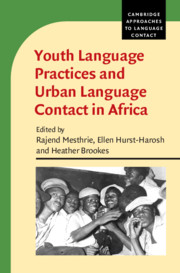Book contents
- Youth Language Practices and Urban Language Contact in Africa
- Cambridge Approaches to Language Contact
- Youth Language Practices and Urban Language Contact in Africa
- Copyright page
- Contents
- Figures
- Tables
- Contributors
- Series Editor’s Foreword
- Preface
- Abbreviations
- Introduction
- 1 Language Contact and Structure in Urban IsiXhosa and Associated Youth Languages
- 2 Not ‘Deep’ but Still IsiXhosa:
- 3 Rethinking Youth Language Practices in South Africa:
- 4 Tsotsitaals, Urban Vernaculars and Contact Linguistics
- 5 Grammatical Hybridity in Camfranglais?
- 6 Sheng and Engsh in Kenya’s Public Spaces and Media
- 7 Exploring Hybridity in Ivorian French and Nouchi
- 8 Authenticity and the Object of Analysis:
- Index
- References
2 - Not ‘Deep’ but Still IsiXhosa:
Young People’s Urban IsiXhosa and Its Relation to Tsotsitaal
Published online by Cambridge University Press: 20 August 2021
- Youth Language Practices and Urban Language Contact in Africa
- Cambridge Approaches to Language Contact
- Youth Language Practices and Urban Language Contact in Africa
- Copyright page
- Contents
- Figures
- Tables
- Contributors
- Series Editor’s Foreword
- Preface
- Abbreviations
- Introduction
- 1 Language Contact and Structure in Urban IsiXhosa and Associated Youth Languages
- 2 Not ‘Deep’ but Still IsiXhosa:
- 3 Rethinking Youth Language Practices in South Africa:
- 4 Tsotsitaals, Urban Vernaculars and Contact Linguistics
- 5 Grammatical Hybridity in Camfranglais?
- 6 Sheng and Engsh in Kenya’s Public Spaces and Media
- 7 Exploring Hybridity in Ivorian French and Nouchi
- 8 Authenticity and the Object of Analysis:
- Index
- References
Summary
This chapter investigates what differentiates Standard isiXhosa, often referred to by speakers as 'deep isiXhosa', from other urban varieties of the language, including Tsotsitaal. It focuses on how the standard variety has an established status, although it is seldom strictly adhered to; dialects and lexical borrowing being some of the key historical drivers of variation in the grammar and vocabulary of the language. Contemporary deviation from the standard is exemplified in the chapter, which draws from research into the speech of the national isiXhosa radio station’s announcers and listeners and into the way young isiXhosa speakers use the language. The data show a flux in the concordial system of isiXhosa, a proliferation of English loanwords and ludic inclusions of Sesotho and Tsotsitaal.
Keywords
- Type
- Chapter
- Information
- Publisher: Cambridge University PressPrint publication year: 2021

